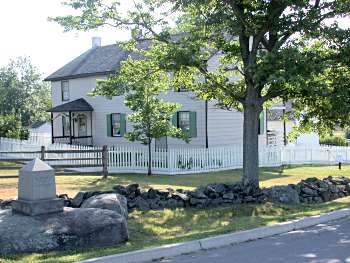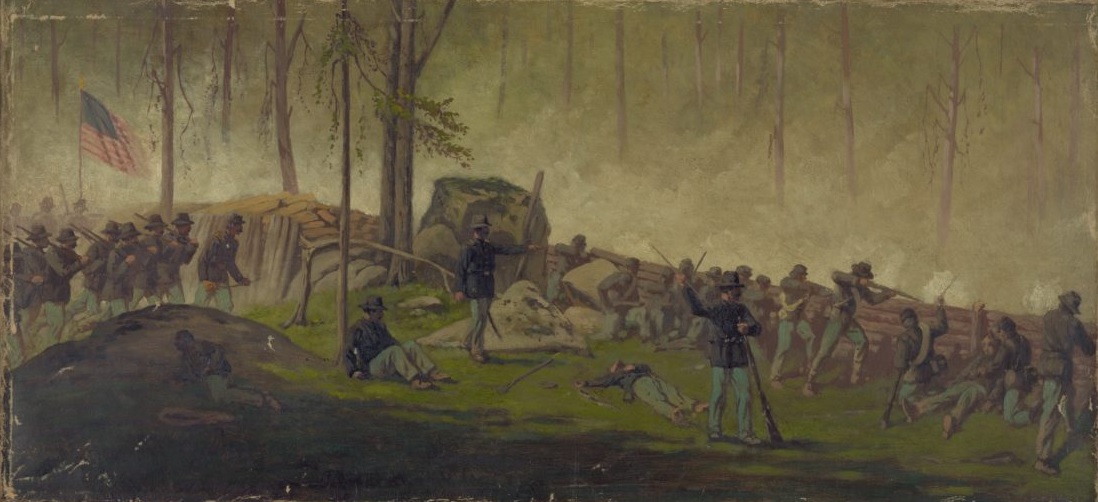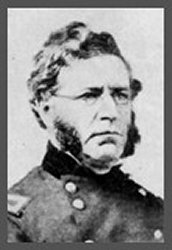The 150th New York at the Battle of Gettysburg
“I was in the fight faithfully till it was over with.” – David Howard, Company I

“Go In Dutchess County” by James Shockley depicts the 150th New York Volunteers of Lockwood’s
Brigade recovering the guns of Bigelow’s Battery near the Trostle Farm, Gettysburg, on July 2, 1863.

Photograph of the Trostle house taken soon after the battle by Timothy H. O’Sullivan

Another view of the Trostle house, also by O’Sullivan

Modern view of the Trostle house, showing the 150th New York marker
in the foreground on the left
“[The regiment’s] first experience in the deadly strife was at the memorable battle of Gettysburgh. Their gallant style and bearing in that terrific conflict excited the admiration of experienced veterans. A prominent officer observing their movements, inquired, ‘What regiment is that with such clean uniforms and glistening bayonets?’ He was told that it was a new regiment, just arrived, the 150th, of New York. ‘Well,’ he replied, ‘if that is the way raw recruits fight, give me a whole army of them.’” – Rev. Sumner Mandeville

“Timid Youths To Hardened Veterans” by James Shockley. On the morning of July 3, 1863, the 150th New York Volunteer Infantry saw
its first combat, its first opponent being none other than the famed “Stonewall Brigade” of the Army of Northern Virginia. The fighting
began from earliest light with members of the regiment claiming to have fired 150 rounds apiece. Their calm, business-like demeanor
led one veteran to remark: “What magic could have occurred to turn these timid youths to hardened veterans?”.

Photograph of the breastworks on Culp’s Hill near Gettysburg taken soon after
the battle by Matthew Brady, at the exact location in the line where the
150th New York had fought on the morning of July 3

Artist’s rendition of the battle for Culp’s Hill, from the Confederate position
(an oil painting by Edwin Forbes)
This painting portrays the Confederate attack on July 3, at around 10:00 a.m.,
at the place in the Union line where the 150th New York was fighting that morning.

Artist’s rendition of the battle for Culp’s Hill, from the Union position
(an oil painting by Edwin Forbes)
This painting portrays the Union defense on July 3, at around 10:00 a.m.,
at or near the place where the 150th New York was fighting that morning.

Artist’s rendition of the battle for Culp’s Hill, from the Union position
(an illustration by Steve Noon)
This painting of the engagement on July 3 portrays the 7th Ohio Infantry,
which was on the immediate left flank of the 150th New York.

Marker for 2nd Brigade, 1st Division, 12th Corps
Culp’s Hill, Gettysburg

Brig. Gen. Henry Hayes Lockwood
_________________________________________________________________________________
Reports of Col. John H. Ketcham, One hundred and fiftieth New York Infantry.
IN CAMP NEAR GETTYSBURG, PA.,
July 4, 1863.
CAPTAIN: In compliance with orders, I have the honor to make the following report of the movements of the One hundred and fiftieth New York Volunteer Infantry during the recent battle near Gettysburg:
This regiment arrived here about 8 a.m. July 2, and was held in reserve on the right until about 6 p.m., when it was ordered with the First Maryland Potomac Home Brigade Volunteers, Colonel Maulsby, to proceed at once and re-enforce General Sedgwick on the extreme left. Upon reaching the battle-ground, these two regiments were ordered forthwith to the front in double-quick time amid the most terrific firing of shell and musketry. They continued to advance until after they had crossed the line of battle of the enemy, the rebels meanwhile retreating, when the firing ceased. The One hundred and fiftieth Regiment New York Volunteers brought off three pieces of artillery which had been abandoned to the enemy.
This regiment then, about 9 p.m., returned to the right, and remained under arms all night, in consequence of heavy skirmishing on the right.
About 4 a.m. we were ordered to support Best’s battery, on the left of the Gettysburg road, where we remained nearly two hours.
About 6 a.m. this regiment was ordered into the rifle-pits on the right, under command of General Geary, where it remained about two and a half hours, when it was relieved. In about an hour it was again ordered into action, where it remained about the same time as before.
The average number of rounds of ammunition expended by each man was 150, and from the large number of dead bodies lying upon the ground, as seen the following morning, it is evident the shots did good execution. A detail from my regiment was made to collect and bury the rebel dead.
The enemy kept up a continuous, direct, and terrible firing of musketry during the whole time engaged. My men rallied to the front in double-quick time, cheering loudly, and they fought earnestly and bravely. Not a man faltered or displayed the least cowardice. This regiment was never before under fire, and for the coolness and courage displayed on this occasion the men are entitled to the highest praise.
After this last engagement it was ordered to a position on the left as a reserve, where it remained until about 6 p.m., when it was ordered into camp.
About 7 a.m. the following morning it was ordered into rifle-pits on the right, where it remained about two hours; then relieved.
I am, captain, very respectfully, your obedient servant,
J. H. KETCHAM,
Colonel One hundred and fiftieth Regiment New York Vols.
Capt. WILLIAM M. BOONE,
Asst. Adjt. Gen., General Lockwood’s Brigade.
—–
KELLY’S FORD, VA., August 13, 1863.
SIR: In compliance with the terms of the circular just received by me, I have the honor to report as follows:
Enlisted men present in the engagement at Gettysburg, Pa.: July 1 (regiment did not reach Gettysburg until the morning of the 2d),–; July 2, 579; July 3, 579.
I am, sir, very respectfully, your obedient servant,
J. H. KETCHAM,
Colonel One hundred and fiftieth New York Volunteers.
Lieut. ROBERT P. DECHERT,
A. A. A. G., Third Brigade.
_________________________________________________________________________________
The James Shockley paintings are used here with the permission of the artist.
A Time To Remember
An article about the Shockley paintings
Return to the 150th Regiment Home Page











